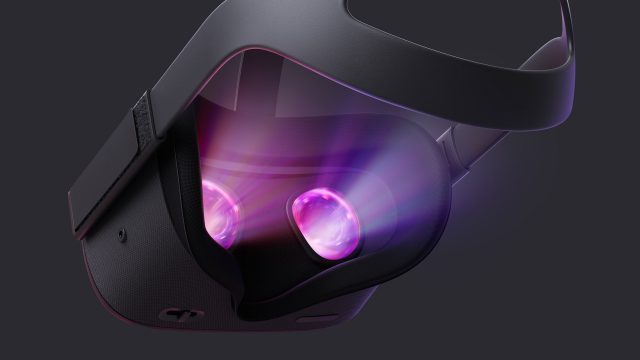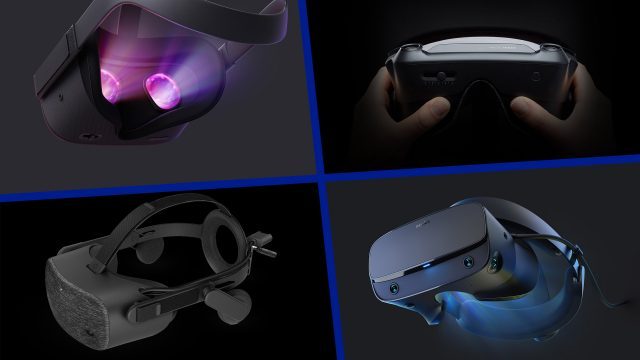If you’ve been paying attention to the VR space at all in 2019, you’ve likely noticed the increasing buzz, no doubt thanks to four major VR headsets set to launch over the course of the next few months. Here’s the quick breakdown of what we know.
Oculus Quest


What is it?
Quest is Oculus’ first standalone VR headset that includes 6DOF tracking on the headset and controllers. That means the movements of your head and hands are tracked in all directions, just like you’d expect on a high-end VR headset, except Quest doesn’t rely on an external PC or trackers—everything is built right in.
This is similar to Oculus Go, except that Go only tracks rotation of the head and hands, which means it can only offer static, seated VR experiences. With full 6DOF tracking, Quest will run some of VR’s best games, like Beat Saber, Superhot VR, Job Simulator, Moss, Robo Recall, and more.
Because it doesn’t have the power of a beefy PC, you can expect graphics to have a decidedly ‘mobile’ feel, but nevertheless it’s very possible to get lost in VR on Quest, even if the graphics are far from what you’d see on a PC VR headset.
Who is it For?
Quest is made for gaming, and most apt for the VR user who isn’t willing to invest in a gaming PC that has enough power to run a PC VR headset. Quest can only run Quest-specific content available on the Oculus Store (Oculus Rift and Oculus Go also have their own separate content libraries).
Given that it is totally standalone, it’s also portable which makes it a great choice for someone who wants the ability to take it from place to place and share the fun with friends.
It’s also likely to be the lowest point of entry for anyone who just wants to be able to play Beat Saber (which has been confirmed as a launch title) for fun or exercise, and it is very likely to be great for that purpose.
When is it Coming Out and How Much?
Oculus says Quest will launch this Spring, but hasn’t offered a more specific release date. With Facebook’s annual developer conference coming up at the end of the month, we’re expecting to see the company either launch the headset at the event outright, or provide a final launch date.
Oculus has confirmed that Quest will cost $400.
[Update] Read our full Oculus Quest review
Oculus Rift S
What is it?
Rift S is Oculus’ second PC VR headset, and the company is positioning it as an easier to use version of Rift—with a few upgrades. The biggest change is that the headset now uses an on-board tracking system which means the external cameras required by the original Rift are not longer necessary. That change will reduce the complexity of setup and the friction of use compared to the original Rift.
Another upgrade over the original Rift S is a new display with a higher resolution that will make graphics sharper and reduce the ‘screen door effect’ (the unlit spaces between pixels), which will make for a step up in clarity. The change in display does come with two downsides though: the move to an LCD display means that darker scenes will look more washed out than with the original Rift, and the headset loses the ability to adjust the distance between lenses (also known as IPD), which reduces the range of users who will fit within its suggested eye-range; you can read more about the supported Rift S IPD range here.
Who is it For?
Rift S is a gaming focused headset that’s best for someone who has or is willing to invest in a gaming PC to get access to the great looking (and playing) content in VR. Rift S can play games from the Oculus Store and SteamVR, which gives players a wide range of options. And, being powered by a PC, graphics are going to be a big step up from any non-PC powered headsets out there like Quest or PSVR. With on-board tracking, it’ll also be easier to set up than headsets which rely on external tracking.
When is it Coming Out and How Much?
Just like Quest, Oculus is only being as specific as “Spring” for the Rift S release date, be we expect that the headset could launch at Facebook’s upcoming developer conference at the end of the month, or at a minimum that we’ll get a specific launch date for Rift S.
Oculus has confirmed that Rift S will cost $400.
[Update] Read our full Rift S review
HP Reverb
What is it?
HP’s Reverb headset is the company’s second PC VR headset which runs Microsoft’s ‘Windows Mixed Reality’ platform, and can also play SteamVR content through an official plugin. Like Rift S, Reverb uses on-board tracking and doesn’t rely on external sensors for tracking.
The biggest upgrades that Reverb brings to the table are an all new design which offers on-ear headphones, as well as new displays which offer a big jump in resolution compared to pretty much any other headset on the horizon.
Who is it for?
HP is positioning Reverb as a professional and enterprise focused headset, but will also sell directly to consumers. Reverb can play VR content from the Windows Mixed Reality store and SteamVR.
With a leading resolution, Reverb seems like it could be a great choice for sim enthusiasts who already have a gaming PC and are looking for maximum clarity. However, because Reverb uses an LCD display, those looking to play space simulators like Elite Dangerous might not like the washed out dark colors compared to a headset with OLED displays.
Because Reverb’s on-board tracking uses just two cameras, its controller tracking coverage isn’t as reliable as Quest or Rift S, which means it might not work as well for certain games which demand maximum reliability, but most content will work just fine.
When is it Coming Out and How Much?
HP says that the Reverb release date is late April, but hasn’t offered a more specific launch date just yet. Considering it’s already the 22nd, we expect to be hearing more very soon!
HP has confirmed that Reverb will cost $600 for the consumer edition and $650 for a professional edition for enterprise use.
Read our latest HP Reverb hands-on
Valve Index
What is it?
Although Valve contributed significant R&D to the HTC Vive, the company’s upcoming Index will be the first PC VR headset made and sold by Valve. Though only limited information is available so far, it seems that Valve is positioning Index as a flagship headset for SteamVR, and it’s thought that the company could announce a least one first-party game to launch with the headset, but we’ll have to wait and see. The headset will launch with the ‘Knuckles’ controllers which Valve has had in the works for many years now (though they plan to call them ‘Valve Index controllers’ moving forward).
Much is still unknown about Index—even the basics like resolution, field of view, and price. While it’s almost certain that Index will use SteamVR Tracking (the same external tracking tech used by the HTC Vive), it’s possible that the headset could offer some form of on-board tracking (considering the cameras seen on the headset), but that’s still entirely up in the air.
Who is it for?
Because there’s still a lot of question marks surrounding Index, it’s hard to know who it will best fit just yet. Our best guess is that Index will be positioned toward existing PC VR enthusiasts, and those looking for a high-end VR experience who are willing to put up with mounting external trackers in their VR space. We’ll be able to refine our expectations soon enough as pre-orders for the headset will be open soon, and by then much more ought to be revealed.
Valve Index can play content from SteamVR. For those not worried about using an unofficial workaround, it will also likely play content from the Oculus Store (via Revive), albeit with some caveats.
When is it Coming Out and How Much?
Valve has confirmed that Index pre-orders will begin May 1st, and by the time that happens we expect to get some essential details about the headset. The actual Index release date is set for sometime in June, though a specific date has not been confirmed. The price of Index is still unknown.
[Update] Read our Valve Index hands-on preview
Update (8:00 AM ET): And what about HTC’s upcoming PC VR headset Cosmos? At the time of this writing, the company is still quoting an ‘Early 2019’ launch window for the headset, so there’s really no telling whether it will compete in the rash of VR headsets confirmed for Spring 2019 launch or not.
Should HTC confirm a Spring launch for the headset, we’ll update with a section dedicated to Cosmos here. In the meantime, here’s a quick breakdown of Cosmos:
The tethered, SteamVR-compatible headset contains four on-board optical sensors that track both the user’s head and controllers positionally. There’s been talk of Cosmos working with smartphones, however HTC hasn’t revealed much more than a single photo of the headset next to an outline of a mobile device. The company is staying tight-lipped on all aspects of Cosmos for now, including price, resolution and recommended specs. Despite its CES 2019 unveiling, there’s been no hands-on with the headset. With what we know, it’s possible Cosmos could compete in the same market segment as Rift S, however with little else to go on, that’s simply conjecture at this point.
Cosmos has passed FCC testing however, so more info could be just around the corner.
– – — – –
Got more questions? We’ve got more answers. Drop us a line in the comments below!

